Experimental convertoplan Curtiss-Wright X-100 (USA)
In the mid-fifties, a group of researchers led by Henry Borst, conducting experiments in the field of aerodynamics, discovered an interesting effect. The phenomenon, called the Radial force principle, was observed during transient conditions of vertical take-off and landing vehicles with pivot rotors (Tilt-prop or convertoplane). When moving the screw from the horizontal to the vertical plane, a certain increase in the upward force was observed. It was found that this effect is most pronounced when using a propeller with blades of small length and large width. At the same time, an increase in lift was achieved at the cost of increased air resistance.
An aircraft using “radial force” should have had some advantages over other vertical take-off techniques. So, the increase in lift allowed to reduce the area of bearing planes used during horizontal flight. This, in turn, gave a gain in mass and frontal resistance of the structure. Another advantage was the reduction of noise, directly related to the use of screws of smaller diameter.
Theoretical studies and testing of models in wind tunnels lasted for some time. This work allowed us to collect all the necessary information and begin to create a full-fledged experimental machine designed for carrying out field tests. Developments on the topic of "radial force" were presented to the management of the corporation Curtiss-Wright. After examining the data collected, the leaders felt that the application of the recently open principles could give the company a certain advantage over competitors. 20 November 1957 of the year was made a principled decision to return the corporation to the aviation industry and develop technology using new unconventional ideas.
In early February of next year, the design team began designing the future experimental aircraft. Already 20 February in one of the shops of the company started the construction of a prototype. Such a rapid start of construction contributed to the chosen method of development. Design and construction were carried out in parallel, helped by the experimental nature of the project. The prototype was a purely demonstrator of technology and was intended only to test new ideas, which to a certain extent reduced the requirements for it.
The pilot project received the working designation X-100. It should be noted that, despite the use of the letter “X”, the project of the Curtiss-Wright company had no relation to the so-called. X-series - a line of experimental aircraft, created by order of the military. The project X-100, in contrast to the developments of the line, was developed on its own initiative and without any coordination with the Pentagon.
The experienced X-100 was intended only for testing and studying the "radial force", which greatly simplified its design. On board the car had to attend only the most important units. Installation of additional equipment, including application systems, was not envisaged. Because of this, the finished prototype did not differ in the complexity of the design, and also had a small size and low take-off weight. At the same time in its design used some materials that have not yet had time to get a large distribution.
The main element of the experienced convertiplane, connecting all the units, was a fairly large fuselage streamlined shape. It was proposed to build on the basis of the frame of aluminum pipes and profiles. A smaller part of the fuselage received a metal skin, while other areas in the center and tail covered with canvas. For most of its length, the fuselage had a section close to a rectangular and having rounded corners. The layout was fairly simple. In the forward part of the fuselage placed a double cabin with a large lantern, behind the cabin was the main gearbox, behind which the engine was placed. A protruding air intake with a rectangular inlet was placed above the gearbox on the upper surface of the fuselage.
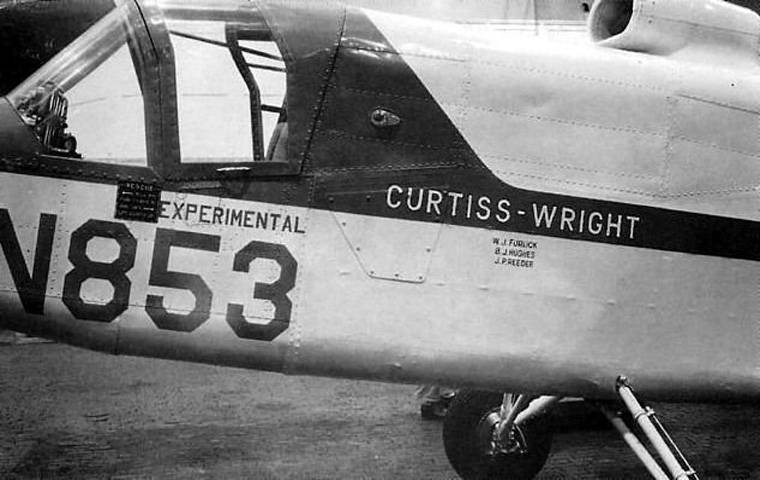
The nose of the fuselage and cockpit. Photo Nhungdoicanh.blogspot.fr
The use of "radial force" allowed to reduce the area of the bearing planes. In this regard, the aircraft received a high-placed straight wing of a small width, on which large gondolas were placed with propellers gearboxes. For greater rigidity of the structure under the wing was stretching, connecting the tip and the bottom of the fuselage. In the tail of the fuselage there was an arrow-shaped keel with a rudder. A rectangular stabilizer with elevators was placed on its top. It was proposed to use tail rudders in horizontal flight with sufficient speed.
At the rear of the fuselage, behind the wing, was a Lycoming YT53-L-1 turbo-shaft engine hp power 825. The motor shaft was connected to the main gearbox, which was necessary to distribute the torque between the two propellers. Inside the wing were two shaft, each of which set in motion its own gearbox. The latter is directly associated with the propeller.
As part of the X-100 project, propellers with blades of the original shape were developed. The width of the blade was maximum in the root part and gradually decreased, forming a trapezoidal structure. The basis of the blade was a spar, on top of which a porous filler was mounted. The outer surface of the blade was formed of fiberglass glue. Such a design of the blade was new for its time, so its testing can also be considered one of the objectives of the pilot project. The blades were placed on the sleeve with an automatic skew. The latter was installed in a rotating nacelle placed on the wing. With the help of appropriate mechanisms screw disk could be placed horizontally, vertically or in an intermediate position.
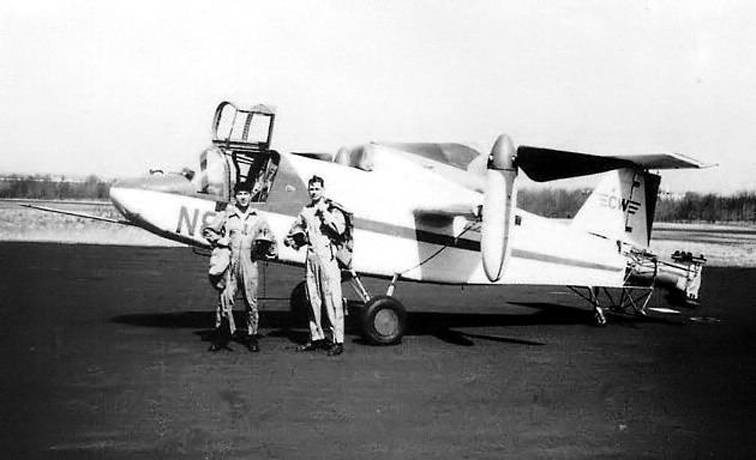
X-100 and its crew. Photo Nhungdoicanh.blogspot.fr
Behind the engine positioned an elongated exhaust pipe, necessary for removal of hot gases from the fuselage, as well as for control in some modes. On the tail section of the pipe placed a special system of deflectors that can change the direction of gas flow. This equipment was to be used to control the main channels during a vertical flight or when horizontal movement to a set speed at which it was possible to use traditional rudders.
The crew of the convertoplan consisted of two people. They were located side by side in the forward double cabin and controlled the work of all units. The aircraft received a large lantern with a large glass area, which provided a good view forward and sideways. The central elements of the lantern folded up to the center, forming hatches for access to the cabin.
The first version of the X-100 project envisaged the use of a three-point chassis. The main racks were made of three tubes and equipped with larger diameter wheels. They were placed directly under the wing. At the rear of the fuselage was a rack with a smaller wheel.
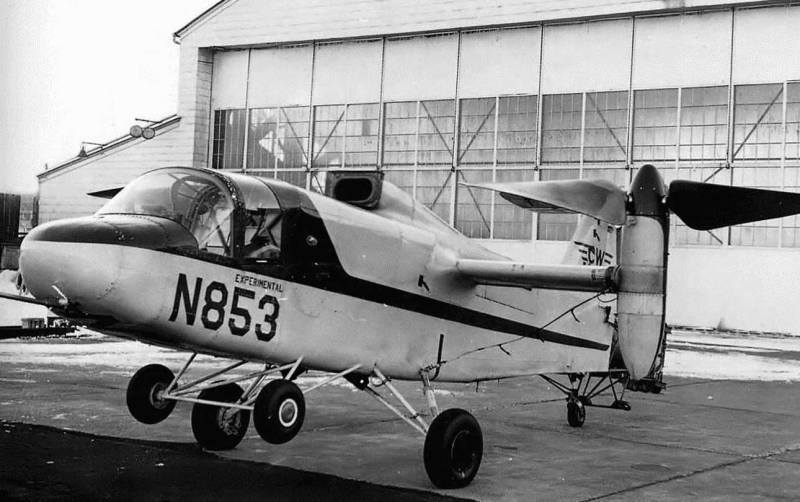
An improved version of the car, visible additional landing gear under the cab. Photo Nhungdoicanh.blogspot.fr
The total length of the aircraft reached 8,65 m, wing span - 7,26 m. The height at the parking lot - 3,28 m. Screw diameter - 3,05 m. Maximum take-off weight was limited to 1691 kg. According to calculations, the maximum horizontal flight speed should exceed 380 km / h.
In the X-100 project, a combined control system was proposed, which made it possible to maintain control in all flight modes. During a vertical take-off or landing, the pilot could differentially change the pitch of the propellers, exercising roll control. The pitch and yaw control was proposed to be performed using jet engine gases deflected by the tail rudders. When the engine is operating at a nominal mode, the tail gas rudder unit could develop vertical thrust up to 64 kg and horizontal thrust up to 18 kg.
The transition to horizontal flight was proposed to carry out with the help of a gradual rotation of the nacelles around the horizontal axis. The mechanisms used were rotated in several steps, each time moving the screws to 10 °. Having developed sufficient speed, the device could use “aircraft” pitch and yaw control. The roll control in all modes was carried out by changing the characteristics of the rotors: a differentiated change in pitch led to a change in lift and turn to the side of the screw with a smaller burden.
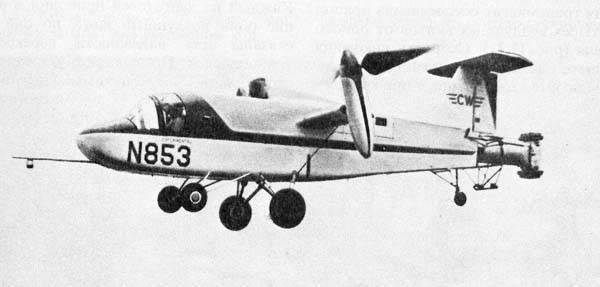
Convertible in vertical flight. Photo Airwar.ru
In October, 1958, the company Curtiss-Wright completed the construction of a prototype machine and handed it over to tests in a NASA wind tunnel. Similar checks showed that the authors of the project were noticeably mistaken in their calculations. So, the real thrust of the propellers turned out to be 10% lower than the calculated one. However, the “radial force” fully compensated for these losses and still allowed to obtain the required characteristics. After testing in a wind tunnel, an experimental car was sent for revision and completion.
December 22 1958, the rolling out of the experimental convertiplane was ready for testing. 14 January 1959-th first started the engine, after which the preliminary ground tests began. The first prototype approach on a leash occurred on April 20. Over the next few months, the unit under the control of test pilot Bill Furlich made test ascents into the air using safety cables. After checking all the main characteristics, a test approach was performed with a change in the position of the rotors.
12 September launched a new phase of testing, during which the experienced X-100 independently and without insurance lifted into the air. At the same time, in order to avoid lifting to an excessive height, the prototype received additional loads. The first test flights without a leash were carried out in the "helicopter" mode at low altitudes. For several days, the device repeatedly rose into the air, carried out various maneuvers and worked in different modes. The maximum flight duration was 20 minutes.
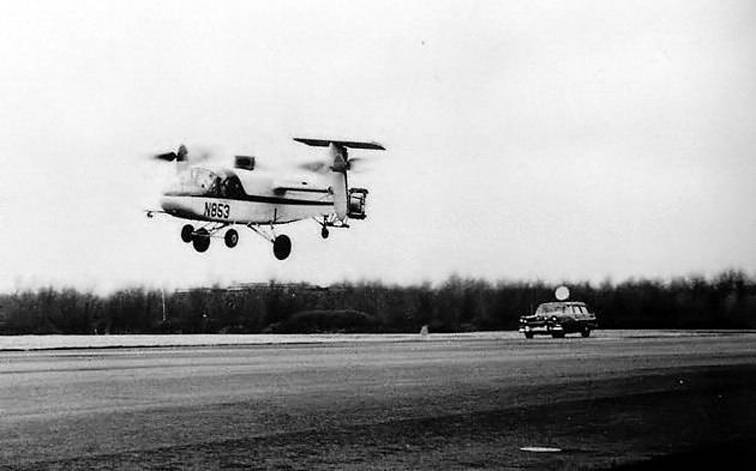
Test flight Photo Nhungdoicanh.blogspot.fr
The test results, in general, gave reason for optimism. The idea of the Radial force principle showed itself well and confirmed the possibility of increasing the basic characteristics in transient conditions. With the further development of existing ideas it was possible to create full-fledged convertoplanes suitable for real practical operation. However, to begin developing them, some issues had to be resolved. Like any other promising technology, the experienced X-100 was not without flaws.
One of the main problems identified during the tests was associated with some transient conditions. At low altitudes, just before the contact, the flow from the rotors bounced off the ground and created numerous turbulences, leading to a noticeable deterioration in controllability. The reduction in engine power required for landing did not allow for obtaining the required thrust of the gas rudders, which made the control of the apparatus more complicated. With inaccurate control at this stage, the machine could hit its nose on the ground. To eliminate such incidents at some point under the cabin of the prototype X-100 installed two additional landing gear with small wheels.
Another serious problem was related to the survivability of the aircraft in case of accidents. With a sudden stop of the engine, the crew could only leave the car: the small diameter propellers used could not create the required lift force in the autorotation mode, and the wing had insufficient characteristics for planning.
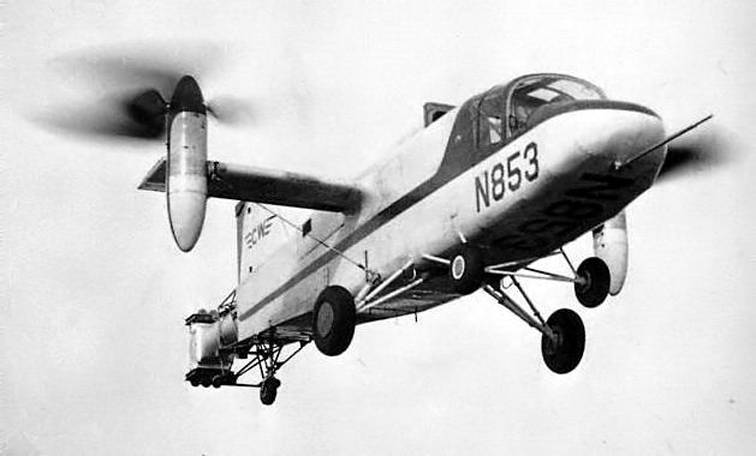
X-100 in flight, visible tail gas rudder unit. Photo Nhungdoicanh.blogspot.fr
Curtiss-Wright test pilots tested the experimental X-100 machine until July of the 1960 year. For a year and a half of various tests, a considerable amount of data was collected, showing the perspectives of original ideas. In August of the same year, the prototype was taken to Langley Air Base, where NASA pilots tested it. Interestingly, the main purpose of these checks was to study the possibility of operating equipment at various sites. Takeoffs and landings were carried out with dirt, grass, sand, etc. In order to avoid unpleasant incidents, such flights were carried out mainly “by helicopter” and on a leash.
October 5 1961, the accident occurred, actually put an end to an interesting project. During the next test flight, the control system failed, which is why an experienced convertiplane fell onto the port side and fell to the ground. A fall from a small height resulted in a noticeable damage to the left pylon with a gearbox, while the other units, in general, did not suffer. An experienced X-100 was subject to repair and was soon restored. However, he never again rose into the air.
By the time of the first serious accident, the only experimental aircraft managed to pass ground tests with a total duration of 220 hours and fly into 14 hours. During this time, the specialists managed to collect a considerable amount of information on the operation of equipment in different modes. The tests fully confirmed the prospects of the “radial force”, which made it possible to begin the development of new projects of such equipment. Designing a new aircraft, suitable for practical operation, began even during the tests X-100 and should have been completed in the very near future. In such circumstances, the resumption of testing experimental machine considered impractical. The new design of the aircraft using rotary screws, received the designation X-200. Subsequently, it was renamed X-19.
After the repair, the only experienced X-100 device remained at NASA airbase, but later it was decided to get rid of it. The experimental model no longer needed was handed over to the National Air and Space Museum of the Smithsonian Institution (Washington). There, the machine is still there, with its own example demonstrating the original attempts of the American aviation industry to master new aircraft designs.
At the heart of the X-100 project was Curtiss-Wright’s desire to test in practice new original ideas related to the improvement of flight data of aviation technology. As a pure technology demonstrator, an experienced aircraft has been used in various tests for several years. Naturally, with such a role, he could not count on any development. Nevertheless, the tests were successful and allowed to explore new ideas and technologies, with the use of which the project X-200 / X-19 was soon created.
On the materials of the sites:
https://airandspace.si.edu/
https://crgis.ndc.nasa.gov/
https://vertipedia.vtol.org/
http://diseno-art.com/
http://nhungdoicanh.blogspot.fr/
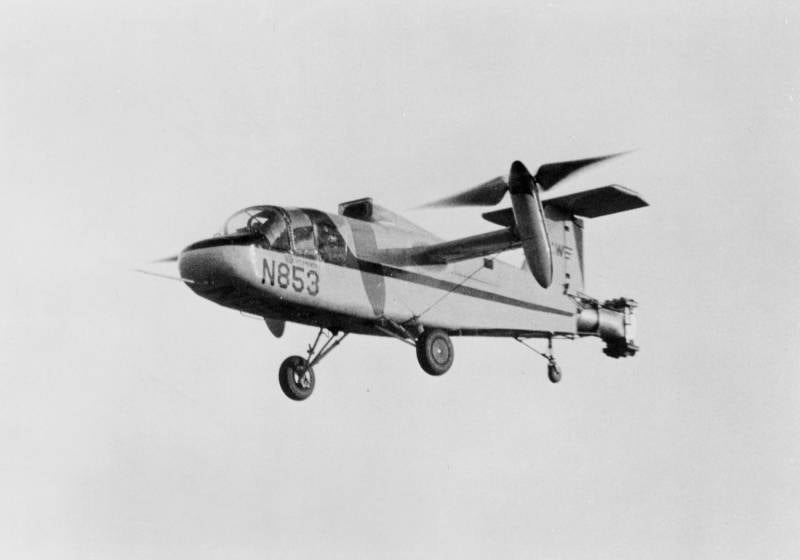
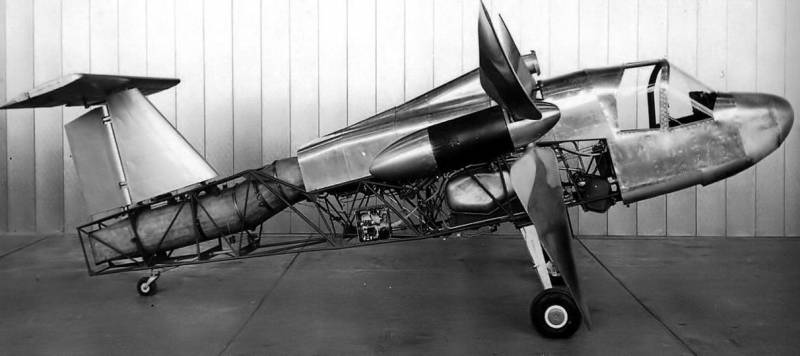
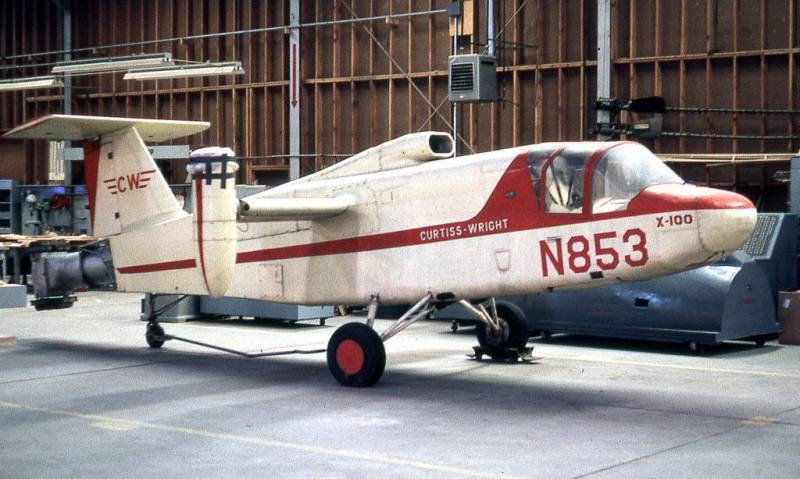
Information